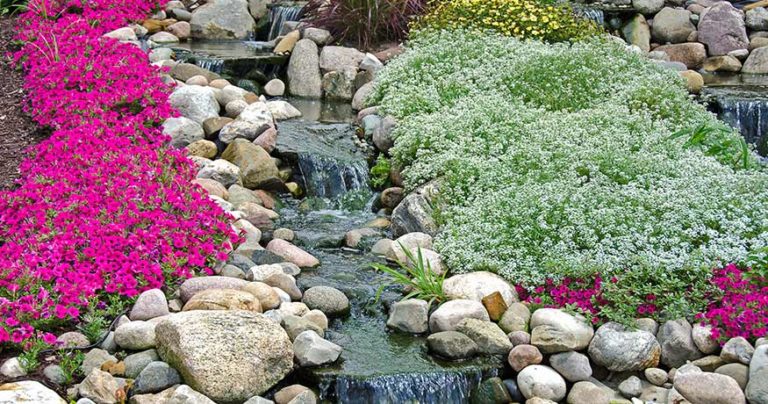Do you have a steep hillside, embankment, or sloped area in your yard that is difficult to mow and maintain? Let mother nature lend a hand by planting ground covers! The right plants can stop erosion, suppress weeds, and bring color and texture to challenging slopes
When choosing ground covers for hills, look for plants that:
- Spread rapidly to stabilize the soil
- Grow dense networks of stems and roots to prevent erosion
- Tolerate poor soil, drought, and full sun exposure on slopes
To give you some options, here are 23 of the best ground cover plants for hills:
Trailing Perennials
-
Creeping Jenny (Lysimachia nummularia) – Bright yellow flowers; zones 3-9
-
Creeping phlox (Phlox subulata) – Mossy foliage with purple, pink or white blooms; zones 3-9
-
Creeping thyme (Thymus praecox) – Dense, fragrant foliage; zones 4-8
-
Blue star creeper (Isotoma fluviatilis) – Light blue starry flowers; zones 5-9
-
Sweet woodruff (Galium odoratum) – Fragrant white flowers; zones 4-8
-
Lilyturf (Liriope spicata) – Grass-like foliage; zones 5-10
Vining Ground Covers
-
Asiatic jasmine (Trachelospermum asiaticum) – Fragrant white blooms; zones 7-10
-
Periwinkle (Vinca minor) – Evergreen foliage with blue flowers; zones 4-9
-
Wintercreeper (Euonymus fortunei) – Evergreen vining shrub; zones 4-8
-
Creeping wire vine (Muehlenbeckia axillaris) – Unique round leaves; zones 5-9
Low-Growing Shrubs
-
Juniper (Juniperus horizontalis) – Trailing blue-green evergreen; zones 3-9
-
Cotoneaster (Cotoneaster dammeri) – Herbaceous shrub with white flowers; zones 5-8
-
Potentilla (Potentilla neumanniana) – Yellow blooming shrub; zones 3-7
-
Sumac (Rhus aromatica) – Red fall foliage and yellow blooms; zones 3-9
Succulents, Moss and Grass
-
Sedum (Sedum spurium) – Drought-tolerant succulent; zones 3-9
-
Moss phlox (Phlox subulata) – Creeping phlox cultivar for full sun; zones 3-9
-
Irish moss (Sagina subulata) – Tiny white flowers resembling pearls; zones 4-8
-
Scotch moss (Sagina subulata ‘Aurea’) – Feathery yellow foliage; zones 4-8
-
Monkey grass (Ophiopogon japonicus) – Lush grass-like foliage for shade; zones 6-10
Annual Ground Covers
-
Sweet alyssum (Lobularia maritima) – Dainty white blooms; zones 4-9
-
Creeping zinnia (Sanvitalia procumbens) – Yellow daisy-like flowers; zones 8-10
-
Blue lobelia (Lobelia erinus) – Vibrant blue flowers; zones 6-11
Native Ground Cover Plants
-
Wild ginger (Asarum canadense) – Shade loving with unique brown blooms; zones 3-8
-
Virginia creeper (Parthenocissus quinquefolia) – Gorgeous red fall color; zones 3-9
-
Bunchberry (Cornus canadensis) – White bracted flowers in spring; zones 2-7
With the right plants, you can stabilize the soil, prevent erosion, and beautify those problematic sloped areas. Visit your local nursery and choose a few tough, fast-spreading ground covers that match your growing conditions. Then watch your hillside bloom!
10 Best Plants for Slopes, Hillsides and Banks in Your Garden Garden Trends
FAQ
What is the best ground cover to plant on a hill?
What is the fastest growing ground cover for a slope?
What is the best plant to plant on a slope?
What is the best low-maintenance ground cover?
- The Ultimate Guide to Growing Strawberries in Raised Beds - August 8, 2025
- No-Dig Garden Beds: The Easiest Way to Grow a Beautiful Garden - August 6, 2025
- How to Protect and Preserve Wood for Raised Garden Beds - August 6, 2025

